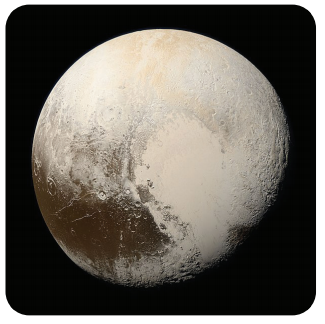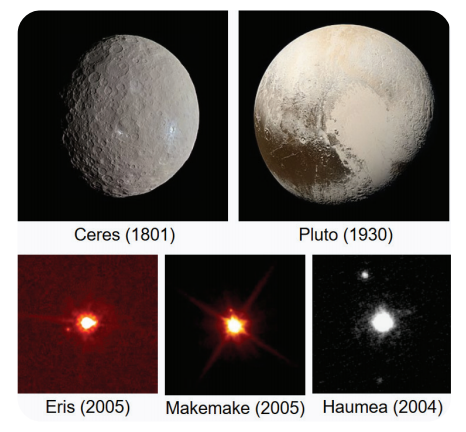Dwarf Planets
Definition
The term dwarf planet is relatively new, it was created in Prague on the 24th August 2006 at the 26th General Assembly of the International Astronomical Union. During this astronomical congress the term planet was newly defined. Hence, the number of known planets in the Solar System decreased to 8 planets. Debates related to this change are sometimes called the “fight for Pluto”. Until then the term “planets” had never been defined and planets of the Solar System were known simply by naming of the objects.
History
Until the year 1781 six planets of the Solar System were known (Mercury, Venus, Earth, Mars, Jupiter, Saturn). These planets do not have their discoverers. In 1781 German astronomer William Herschel discovered the planet Uranus and the number of known planets increased to 7. Between the years 1801 and 1845 the number of planets varied, some scientists included there also newly found objects between Mars and Jupiter, e. i. minor planets Vesta, Juno, Ceres and Pallas. In 1846 German astronomer Johann Gottfried Galle discovered planet Neptune. From 1854 to 1930 the planets were Mercury, Venus, Earth, Mars, Jupiter, Saturn, Uranus and Neptune. In 1930 American astronomer Clyde Tombaugh discovered a new object, Pluto, which was at that time included in the planets of the Solar System and the number of the known planets increased to 9. That changed on the 24th August 2006 when Pluto was excluded and reclassified into a newly created category “dwarf planets”.

Pic. 1: The image of dwarf planet Pluto taken in 2014 by New Horizons space probe from a distance of 35,500 km
(source: https://en.wikipedia.org/wiki/File:Pluto_in_True_Color_-_High-Res.jpg)
A dwarf planet is an object of the Solar System. Such object is similar to a planet and has to fulfil the following criteria:
1. orbits the Sun;
2. has enough mass so that its gravitational forces form it into a nearly round shape (is in hydrostatic balance);
3. during its development has not cleared the neighbourhood around its orbit in order to become dominant in the zone;
4. is not a satellite.
The International Astronomical Union currently (March 2019) recognizes five dwarf planets:
| Catalogue Number |
Name | Location | Diameter D (km) |
Semi-major axis a (au) |
Trajectory Inclination i (°) |
Trajectory Eccentricity e (-) |
Mass m (kg) |
Year of Discovery |
| 1 | Ceres | 1) | 949 | 2,77 | 11 | 0,0758 | 9 · 1 020 | 1801 |
| 134340 | Pluto | 2) | 2 377 | 39,5 | 17 | 0,2488 | 1 · 1 022 | 1930 |
| 136108 | Haumea | 3) | 1 632 | 43,2 | 28 | 0,191 | 4 · 1 021 | 2004 |
| 136472 | Makemake | 4) | 1 430 | 45,7 | 29 | 0,156 | 4 · 1 021 | 2005 |
| 136199 | Eris | 5) | 2 326 | 67,8 | 44 | 0,411 | 2 · 1 022 | 2005 |
It is highly likely that the category of dwarf planets will include more objects in the future.

(source: https://en.wikipedia.org/wiki/Dwarf_planet)


